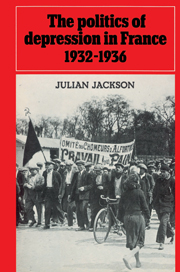Book contents
- Frontmatter
- Contents
- Acknowledgements
- Abbreviations
- Introduction
- PART 1 THE BACKGROUND
- PART 2 THE COURSE OF POLICY: GOVERNMENT AND OPPOSITION 1932–1936
- 4 From le 8 Mai to le 6 Février: the misunderstanding
- 5 Varieties of deflation 1934–1936
- 6 The programme of the Popular Front
- PART 3 NON-CONFORMISTS OF LEFT AND RIGHT
- Epilogue: The politics of rearmament 1936–1939
- Conclusion
- Appendix
- Notes
- Bibliography
- Index
5 - Varieties of deflation 1934–1936
Published online by Cambridge University Press: 02 November 2009
- Frontmatter
- Contents
- Acknowledgements
- Abbreviations
- Introduction
- PART 1 THE BACKGROUND
- PART 2 THE COURSE OF POLICY: GOVERNMENT AND OPPOSITION 1932–1936
- 4 From le 8 Mai to le 6 Février: the misunderstanding
- 5 Varieties of deflation 1934–1936
- 6 The programme of the Popular Front
- PART 3 NON-CONFORMISTS OF LEFT AND RIGHT
- Epilogue: The politics of rearmament 1936–1939
- Conclusion
- Appendix
- Notes
- Bibliography
- Index
Summary
Notre devoir était de maintenir le crédit de l'Etat par une gestion économique et financière qui nous valait la confiance des épargnants dans la monnaie.
(Louis Germain-Martin, Le Problème de la dévaluation du franc en 1934)After 6 February 1934, discussion of economic policy, as opposed to a narrow concentration on government finances, occupied a more central position than during the previous two years. There were three reasons for this. First, it was generally agreed, especially on the left, that the underlying cause of the violence lay in the economic crisis. Secondly, in solving the political problem of the previous 18 months, the events of February freed space for the discussion of economic policy. There could be no question among the Socialists about their attitude to Doumergue's government, and so it was now possible to discuss policy rather than, as in 1932 and 1933, merely political tactics. On the right the financial issue had been largely presented as a problem of political bad faith, as a consequence of the Radical Party's failure to accept its responsibilities. But once the right was again in power and the government had been granted the authority to issue decree laws, the political aspect of the budgetary question was largely resolved, and attention was directed towards the economy. For the Radicals, however, tactical political questions continued for a while to dominate. This was not only a sign of the congenitally ‘political’ nature of the Radical sensibility, it also reflected the fact that for the Radicals 6 February had solved nothing.
- Type
- Chapter
- Information
- The Politics of Depression in France 1932–1936 , pp. 80 - 111Publisher: Cambridge University PressPrint publication year: 1985



